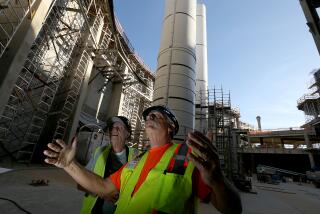Work Shows ‘Our Greatest Asset in Space Is Human Adaptability’ : Crew Prepares for 2nd Building Project Outside Shuttle
- Share via
HOUSTON — As the “Ace Construction Company” aboard the space shuttle Atlantis rested Saturday in preparation for another building project today, scientists on the ground pronounced themselves “well satisfied” with the efforts of the astronauts, who made history by assembling structures outside a spaceship.
The work of mission specialists Jerry Ross and Sherwood Spring on Friday showed that “our greatest asset in space is human adaptability,” said Douglas Heard of the NASA/Langley Research Center in Hampton, Va.
The two astronauts spent 5 1/2 hours assembling and then disassembling two structures, an experiment that NASA considers critical to its plans for construction of a permanent space station in the 1990s.
Faster Than Normal Time
Heard was the chief designer of ACCESS, a 45-foot-long triangular truss that the astronauts erected and took apart in the first stage of their space walk. Ross and Spring spent 55 minutes on assembly and disassembly of ACCESS, Heard said, slightly faster than the 58 minutes normally required on earth in an underwater neutral buoyancy facility.
The scientists had worried about the mission specialists’ hands becoming cold during short periods of inactivity, as had occurred on earlier space walks, but that did not occur.
However, the astronauts did report that the work was “very fatiguing for their upper wrists and hands and that they suffered numb fingers and numb thumbs,” said David Akin of the Massachusetts Institute of Technology. But those effects were not a complete surprise and were attributed to the tight-fitting gloves and rigid wrist joints on the astronauts’ suits.
Akin was the chief designer of EASE, an inverted tetrahedron assembled from six 12-foot-long aluminum beams. Ross and Spring built and stowed the structure eight times during their excursion outside. Akin said Saturday that he was surprised by their work.
‘Body Stayed in Position’
“I had expected to see some, for lack of a better word, flailing around, trouble handling their body position,” Akin said. But after Ross’ second cycle of building and stowing from the top of the structure, Akin noted that “his body stayed in position, and the beams just drifted into place.”
Akin said that he had expected the astronauts to take longer in space to assemble EASE than they had underwater. “But the first cycle was about the same as in water,” he said. “By the end, their times were as good as, if not better than, their best times in water.”
Despite the increased speed of assembly, “sketchy metabolic data relayed to the ground indicated they were actually doing less work during the final cycle,” John Cox, flight director, said Saturday. This confirmed that the astronauts had found quicker and easier ways to assemble the structure.
“We definitely saw the initial trends” toward astronauts becoming “a creature of zero gravity,” Akin said.
Welcome Chance to Rest
Nevertheless, after their excursion outside the shuttle, the astronauts said they were glad that they did not have to go back out Saturday and welcomed the chance to rest up, Cox said.
Today, the pair are scheduled to don their space-helmet hard hats once more. This time, each of the structures will be freed from its mount and manipulated by the astronauts. Previous space walkers have handled more massive items, but scientists are eager to learn how easily the astronauts can maneuver long items--particularly when the handling must be performed from one end.
Simulating Repair Work
They will also practice building the two structures with their feet anchored to the shuttle’s robot arm and simulate repair work and installation of electrical cables on the structures.
Akin and Heard are already planning more complex experiments they would like to attempt on future shuttle missions. Akin is also developing a robot that can perform construction tasks, but so far the robot is only about 20% as fast as the astronauts.
The Atlantis crew spent most of Saturday continuing to monitor the on-board experiments, which include the growth of organic crystals and the purification of a hormone called erythropoietin.
Late Saturday afternoon, Rodolpho Neri Vela, the first Mexican astronaut, received a congratulatory call from Mexico’s president, Miguel de la Madrid.
More to Read
Sign up for Essential California
The most important California stories and recommendations in your inbox every morning.
You may occasionally receive promotional content from the Los Angeles Times.













